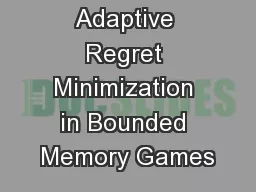PPT-Resolve and Regret
Author : conchita-marotz | Published Date : 2016-07-01
Chapter 4 Code Blue Health Science Edition 4 Supplementary Discussion 1 Taking the Reins In this chapter Wes Douglas assumes the reins of Brannan Community Hospital
Presentation Embed Code
Download Presentation
Download Presentation The PPT/PDF document "Resolve and Regret" is the property of its rightful owner. Permission is granted to download and print the materials on this website for personal, non-commercial use only, and to display it on your personal computer provided you do not modify the materials and that you retain all copyright notices contained in the materials. By downloading content from our website, you accept the terms of this agreement.
Resolve and Regret: Transcript
Download Rules Of Document
"Resolve and Regret"The content belongs to its owner. You may download and print it for personal use, without modification, and keep all copyright notices. By downloading, you agree to these terms.
Related Documents














